

DOK_Question_Stems.pdf. Blooms%20Taxonomy%20questions.pdf. Questioning techniques. 25 Question Stems Framed Around Bloom's Taxonomy. 25 Question Stems Framed Around Bloom’s Taxonomy While critical thinking is a foundation rather than a brick, how you build that foundation depends on the learning process itself: exposing students to new thinking and promoting interaction with that thinking in a gradual release of responsibility approach.

Question stems can be a powerful part of that process no matter where the learner is. Assessment (pre-assessment, self-assessment, formative and summative assessment), prompting and cueing during discussion, etc. In that light, the following 25+ question stems framed around the early, non-revised Bloom’s Taxonomy are worth a gander. Image attribution flickr enokson; 25 Question Stems Framed Around Bloom’s Taxonomy. Formative Assessment Tech Tools - Keystone Area Education Agency. Formative Assessment or Assessment for Learning Formative assessment is a process, not an assessment tool or instrument, which includes collecting information on student progress toward a learning goal.
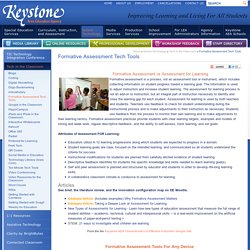
Cloud-based Teaching & Learning Platform for Teachers & Administrators. MakingitHappenFormativeAssessmentEducationalTechnologies-169721. Formative%20Assessment%20-%20Fifty-Four%20Examples.pdf. Formative-assessment_single.pdf. Formative_Assessment_Clip.pdf. EdLeader21_OECD_TFS_Toolkit. College-career. College Ready Assessments. Valid assessment of key deeper learning, 21st century skills like critical thinking, problem solving, argumentation, and clear communication require assessments that allow students to directly apply and demonstrate those skills.
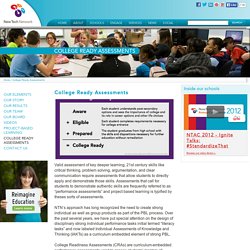
Assessments that call for students to demonstrate authentic skills are frequently referred to as “performance assessments” and project based learning is typified by theses sorts of assessments. NTN’s approach has long recognized the need to create strong individual as well as group products as part of the PBL process. Over the past several years, we have put special attention on the design of disciplinary strong individual performance tasks initial termed “literacy tasks” and now labeled Individual Assessments of Knowledge and Thinking (IAKTs) as a curriculum embedded element of strong PBL.
Check out the NTN sample Rubric here Learn more about the New Tech Network design here. The Lexile® Framework for Reading. You need to register to use the Lexile Analyzer.
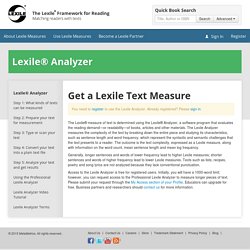
Already registered? Please sign in. The Lexile® measure of text is determined using the Lexile® Analyzer, a software program that evaluates the reading demand—or readability—of books, articles and other materials. The Lexile Analyzer measures the complexity of the text by breaking down the entire piece and studying its characteristics, such as sentence length and word frequency, which represent the syntactic and semantic challenges that the text presents to a reader. The outcome is the text complexity, expressed as a Lexile measure, along with information on the word count, mean sentence length and mean log frequency.
Generally, longer sentences and words of lower frequency lead to higher Lexile measures; shorter sentences and words of higher frequency lead to lower Lexile measures. How to Use Formative Assessment in the TK Classroom. The Process | Using Key Early Learning Standards for Planning | TK/K Combination Classrooms | Dual Language Learners | Special Needs and Response to Intervention | Classroom Example Snapshots Formative assessment helps you determine your students’ academic and social-emotional development on an ongoing basis, and is well aligned with developmentally appropriate transitional kindergarten instruction.

As a TK teacher, you plan activities to stimulate exploration and learning which provide multiple opportunities each day to observe emerging learning. Khan Academy. Guide_to_Assessment_Aug2011.pdf. Information About What Works Best For Learning. F-10 Overview - Introduction - The Australian Curriculum v7.4. The Australian Curriculum sets consistent high standards for what all young Australians should learn as they progress through schooling.
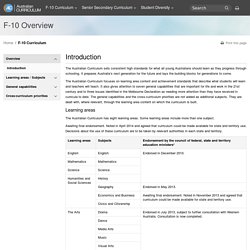
It prepares Australia’s next generation for the future and lays the building blocks for generations to come. The Australian Curriculum focuses on learning area content and achievement standards that describe what students will learn and teachers will teach. It also gives attention to seven general capabilities that are important for life and work in the 21st century and to three issues identified in the Melbourne Declaration as needing more attention than they have received in curricula to date.
The general capabilities and the cross-curriculum priorities are not added as additional subjects. 60 Non-Threatening Formative Assessment Techniques. 60 Non-Threatening Formative Assessment Techniques by TeachThought Staff As frequently as a chef needs to check a sauce for taste, teachers should check for understanding.
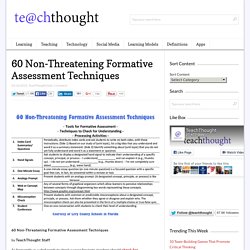
These can be formal–formative or summative assessment, multiple choice, short answer, essay, matching, and related iconic “test” forms. 24information-haveyouever.pdf. Argument Lesson Plans. 200 Prompts for Argumentative WritingPrompts by category for the student who can't think of anything to write about.
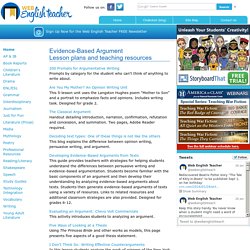
Are You My Mother? An Opinion Writing UnitThis 5-lesson unit uses the Langston Hughes poem "Mother to Son" and a portrait to emphasize facts and opinions. Opinion-Argument%20Resource%20packet%203%20-6.pdf. Argumentative Writing. Introandchapter1.pdf. Argument. Global Center For College & Career Readiness. Common Core State Standards / Webb's Depth of Knowledge (DOK) ELLs_DOK_levels. ShopTalk_Spr_09.pdf. Untitled. Dok-question-stems. Formative Assessment on Pinterest.
Formative assessment - Google Slides. Formative Assessments. Formative Assessments are used to inform the teacher and the student.

They are an informal diagnostic tool used by teachers to help guide and modify instruction. The importance of formative assessment is to help students gain understanding in their learning as well as give teachers a reteaching tool to offer clarity in a lesson. Teachers become facilitators of learning and can more easily recognize opportunities for differentiation, tiered learning, and scaffolding as well as acceleration. They are able to offer engaging student lessons and activities and can adapt flexible learning groups to targeted content. By focusing on student-centered activities, a student is able to relate the material to his life and experiences. When incorporated into classroom practice, the formative assessment process provides information needed to adjust teaching and learning during instruction rather than after. Formative Assessment Lessons (beta)
Read more about the purpose of the MAP Classroom Challenges… Mathematical goals This lesson unit is intended to help students to:
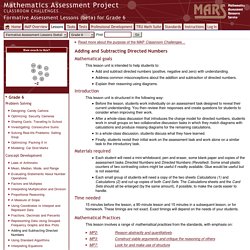
Store.scholastic.com/content/stores/media/products/samples/21/9780545087421.pdf. Fantastic Formative Assessment Tools that Give Great Feedback. Formative assessments are an important way to meet our students' learning needs. When we can see what our students know (or don't know) we can better adjust our teaching to meet them right at their level. Beyond giving feedback, the best formative assessments help students recognize and value the process of learning, not just the outcomes.
These reflective, metacognitive moments can foster kids' genuine excitement, engagement, and lifelong learning. There are lots of digital -- and non-digital -- formative assessment methods that teachers can employ. At times, something as simple as a show of hands, or a physical "thumbs up; thumbs sideways; thumbs down" poll can be just the right thing. Www.levy.k12.fl.us/instruction/Instructional_Tools/60FormativeAssessment.pdf. 33 Digital Tools for Advancing Formative Assessment in the Classroom.
I came across a great blog post the other day – Formative Assessments Are Easier Than You Think – that told the firsthand account of a teacher, Steven Anderson, who implemented formative assessment in his classroom. He used a sticky-note version of an exit ticket to elicit evidence of student learning and in his words, “what a difference that made.” Formative assessment is ‘easier than you think’ and with all the digital tools and apps now available for mobile devices it’s even easier.
We’ve shared some digital tools before and with the five tools that Steven shared combined with our earlier suggestions there are now 33 digital tools that we’ve uncovered that are free or inexpensive and help teachers implement formative assessment in their classrooms. Here they are: A few of Steven’s discoveries: Informal_Assessment_Strategies.pdf. Formative_Informal.pdf.
Schools.nyc.gov/NR/rdonlyres/EC2960D4-0430-4E94-9E49-F029671AF73C/0/TrucksMathTask.pdf. Www.aps.edu/rda/documents/resources/Webbs_DOK_Guide.pdf. Www.mathedleadership.org/docs/resources/jumpstart/NCSM_JumpStart_Overview_Position_Paper.pdf. Teachers/wp-content/uploads/2014/08/Positive-Classroom-Norms.pdf. Www.nctm.org/uploadedFiles/Research_News_and_Advocacy/Research/Clips_and_Briefs/Research_brief_04_-_Five_Key Strategies.pdf. Formative Assessment. A Position of the National Council of Teachers of Mathematics Question: What is the role of formative assessments in mathematics education? Formative assessment is an essential process that supports students in developing the reasoning and sense-making skills that they need to reach specific learning targets and move toward mastery of the mathematical practices set out in the Common Core State Standards. It serves to inform both the teacher and the learner, enabling the teacher to change what he or she is doing and the student to understand where he or she is in relation to the learning goal.
In other words, formative assessment provides information that changes what both the teacher and the learner are doing. The United Kingdom Assessment Reform Group has laid out five requirements for assessment to improve learning (Hattie, 2012): Linking assessment to everyday classroom instruction requires teachers to make a shift in both their thinking and their practice. Black, P. Usny.nysed.gov/rttt/teachers-leaders/practicerubrics/Docs/nyla-rubric.pdf. Www.ncpublicschools.org/docs/dtl/standards/professional/rubric-evaluating.pdf. Creating S.M.A.R.T. Goals — Top Achievement. Specific Measurable Attainable Realistic Timely Specific: A specific goal has a much greater chance of being accomplished than a general goal.
*Who: Who is involved? *What: What do I want to accomplish? Danielson Group » The Framework. Loading... The Framework for Teaching is a research-based set of components of instruction, aligned to the INTASC standards, and grounded in a constructivist view of learning and teaching. The complex activity of teaching is divided into 22 components (and 76 smaller elements) clustered into four domains of teaching responsibility: Each component defines a distinct aspect of a domain; two to five elements describe a specific feature of a component. Levels of teaching performance (rubrics) describe each component and provide a roadmap for improvement of teaching.
The Framework may be used for many purposes, but its full value is realized as the foundation for professional conversations among practitioners as they seek to enhance their skill in the complex task of teaching. Evaluation Forms - Educator Evaluation. Bartle/
Using Manipulatives. Page 1 of 4 What Is It? Number Line Primary Resources - Number lines. Number Sense Series: A Sense of 'ten' and Place Value. You can read an updated version of this article in our Number Sense and Place Value Feature. Once a basic number sense has developed for numbers up to ten (see Developing Early Number Sense) a strong 'sense of ten' needs to be developed as a foundation for both place value and mental calculations. (This is not to say that young children do not have an awareness of much larger numbers.
Indeed, there is no reason why children should not explore larger numbers while working in depth on 'tenness'). Ten Frames and Dot Cards. Ten frames and dot cards can be used to develop students’ subitizing skills, the ability to “instantly see how many”. This skill plays a fundamental role in the development of students’ understanding of number. Two types of subitizing exist. Perceptual subitizing is closest to the original definition of subitizing: recognizing a number without using other mathematical processes. Wp-content/uploads/10_NCTM_MC_TenFrames.pdf. What is a Ten Frame.pdf. Case-for-hands-on-learning.pdf. Hands-On Is Minds-On. Why_Teach_Math_with_Manips.pdf. Ncsm_positionpaper Manipulatives.pdf. 7 Strats Ch 1.pdf. Www.nctm.org/uploadedFiles/Research_News_and_Advocacy/Research/Clips_and_Briefs/Research_brief_05_-_Formative_Assessment.pdf.